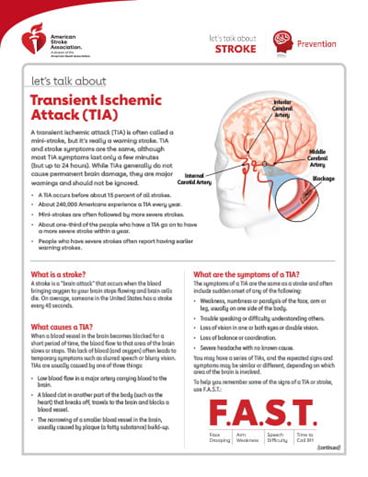Let’s Talk About Transient Ischemic Attack (TIA)
 A transient ischemic attack (TIA) is often called a mini-stroke, but it’s really a warning stroke. TIA and stroke symptoms are the same, although most TIA symptoms last only a few minutes (but up to 24 hours). While TIAs generally do not cause permanent brain damage, they are major warnings and should not be ignored.
A transient ischemic attack (TIA) is often called a mini-stroke, but it’s really a warning stroke. TIA and stroke symptoms are the same, although most TIA symptoms last only a few minutes (but up to 24 hours). While TIAs generally do not cause permanent brain damage, they are major warnings and should not be ignored.
- A TIA occurs before about 15 percent of all strokes.
- About 240,000 Americans experience a TIA every year.
- Mini-strokes are often followed by more severe strokes.
- About one-third of the people who have a TIA go on to have a more severe stroke within a year.
- People who have severe strokes often report having earlier warning strokes.
What is a stroke?
A stroke is a “brain attack” that occurs when the blood bringing oxygen to your brain stops flowing and brain cells die. On average, someone in the United States has a stroke every 40 seconds.
What causes a TIA?
When a blood vessel in the brain becomes blocked for a short period of time, the blood flow to that area of the brain slows or stops. This lack of blood (and oxygen) often leads to temporary symptoms such as slurred speech or blurry vision. TIAs are usually caused by one of three things:
- Low blood flow in a major artery carrying blood to the brain.
- A blood clot in another part of the body (such as the heart) that breaks off, travels to the brain and blocks a blood vessel.
- The narrowing of a smaller blood vessel in the brain, usually caused by plaque (a fatty substance) build-up.
What are the symptoms of a TIA?
The symptoms of a TIA are the same as a stroke and often include sudden onset of any of the following:
- Weakness, numbness or paralysis of the face, arm or leg, usually on one side of the body.
- Trouble speaking or difficulty understanding others.
- Loss of vision in one or both eyes or double vision.
- Loss of balance or coordination.
- Severe headache with no known cause.
You may have a series of TIAs, and the repeated signs and symptoms may be similar or different, depending on which area of the brain is involved.
To help you remember some of the signs of a TIA or stroke, use F.A.S.T.:
- F - Face drooping
- A - Arm weakness
- S - Speech difficulty
- T - Time to call 911
How is a TIA diagnosed and treated?
You cannot tell whether you are having a stroke or a TIA, so you should call 911 right away. A diagnosis of TIA can only be determined after an assessment by a health care provider, which can include blood tests, X-rays, ultrasound scanning, a magnetic resonance imaging (MRI), a computed tomography (CT) scan and tests to find out whether there are heart-related problems, such as an irregular heartbeat.
Since TIA symptoms resolve on their own, your health care provider will likely work with you to address the underlying causes to prevent additional TIAs or a stroke. Treatment options will depend upon the cause or causes, your medical history, and the results of any testing. Treatment often includes medication and lifestyle changes and could include surgery. Effective treatment may help reduce your risk for stroke or another TIA.
TIA risk factors:
Anyone can have a TIA, but the risk increases with age. Some of the controllable risk factors for TIAs include high blood pressure, smoking, cardiovascular disease, diabetes, blood clots and alcohol abuse.
If you’ve previously had a stroke, pay careful attention to the signs of TIA, because they could signal a second stroke in your future. If you’ve already had at least one TIA, you are almost 10 times more likely to have a stroke than someone of the same age and sex who hasn’t.
How can I learn more?
- Call 1-888-4-STROKE (1-888-478-7653) or visit stroke.org to learn more about stroke or find local support groups.
- Sign up for the Stroke Connection, a free digital magazine for stroke survivors and caregivers, at StrokeConnection.org.
- Connect with others who have also had an experience with stroke by joining our Support Network at stroke.org/SupportNetwork.
Do you have questions for the doctor or nurse?
Take a few minutes to write your questions for the next time you see your health care provider. For example:
Which facility close to me is best equipped to treat me if I am having TIA symptoms?
What medical conditions do I have that put me at higher risk for TIA?
How can I reduce my risk for TIA?
We have many other fact sheets to help you make healthier choices, manage your condition or care for a loved one.
Visit stroke.org/LetsTalkAboutStroke to learn more
© Copyright 2020 American Heart Association, Inc., a 501(c)(3) not-for-profit. All rights reserved. American Stroke Association is a registered trademark of the AHA. Unauthorized use prohibited. DS15720 1/20